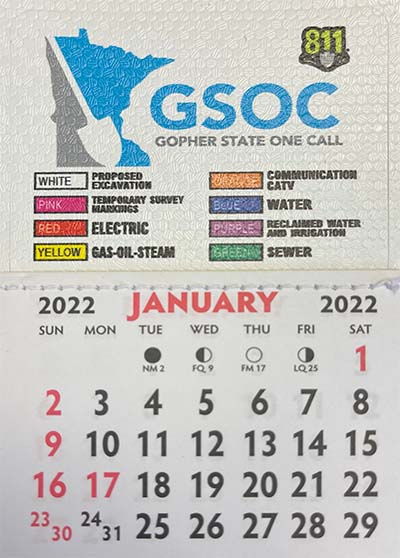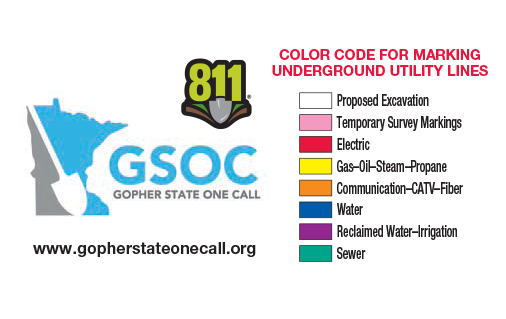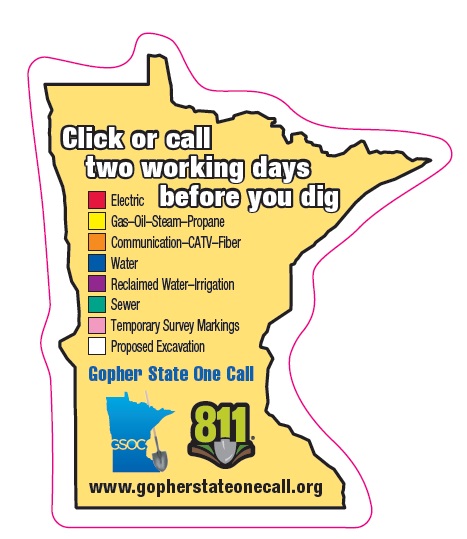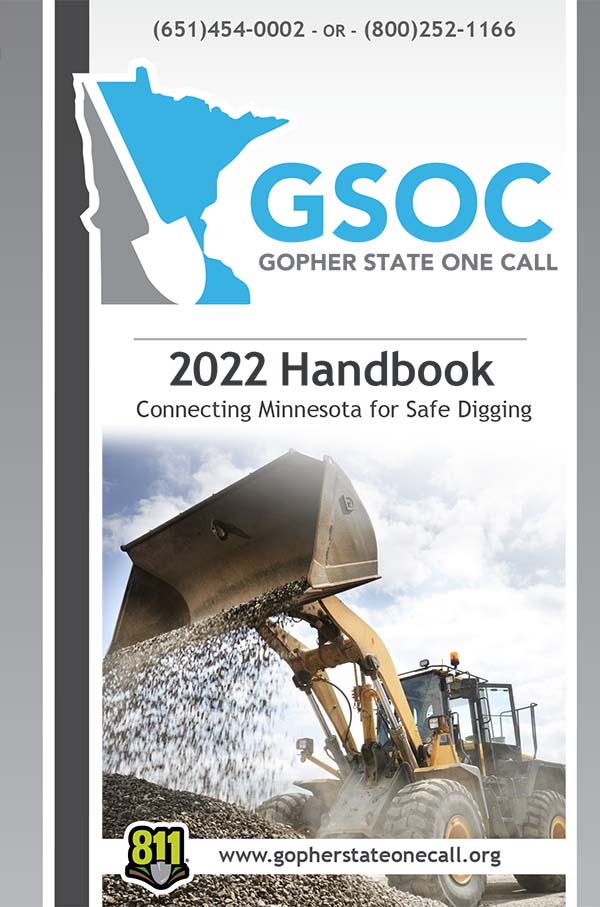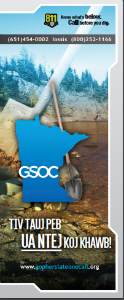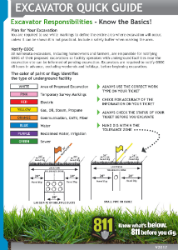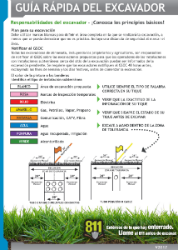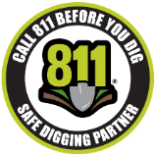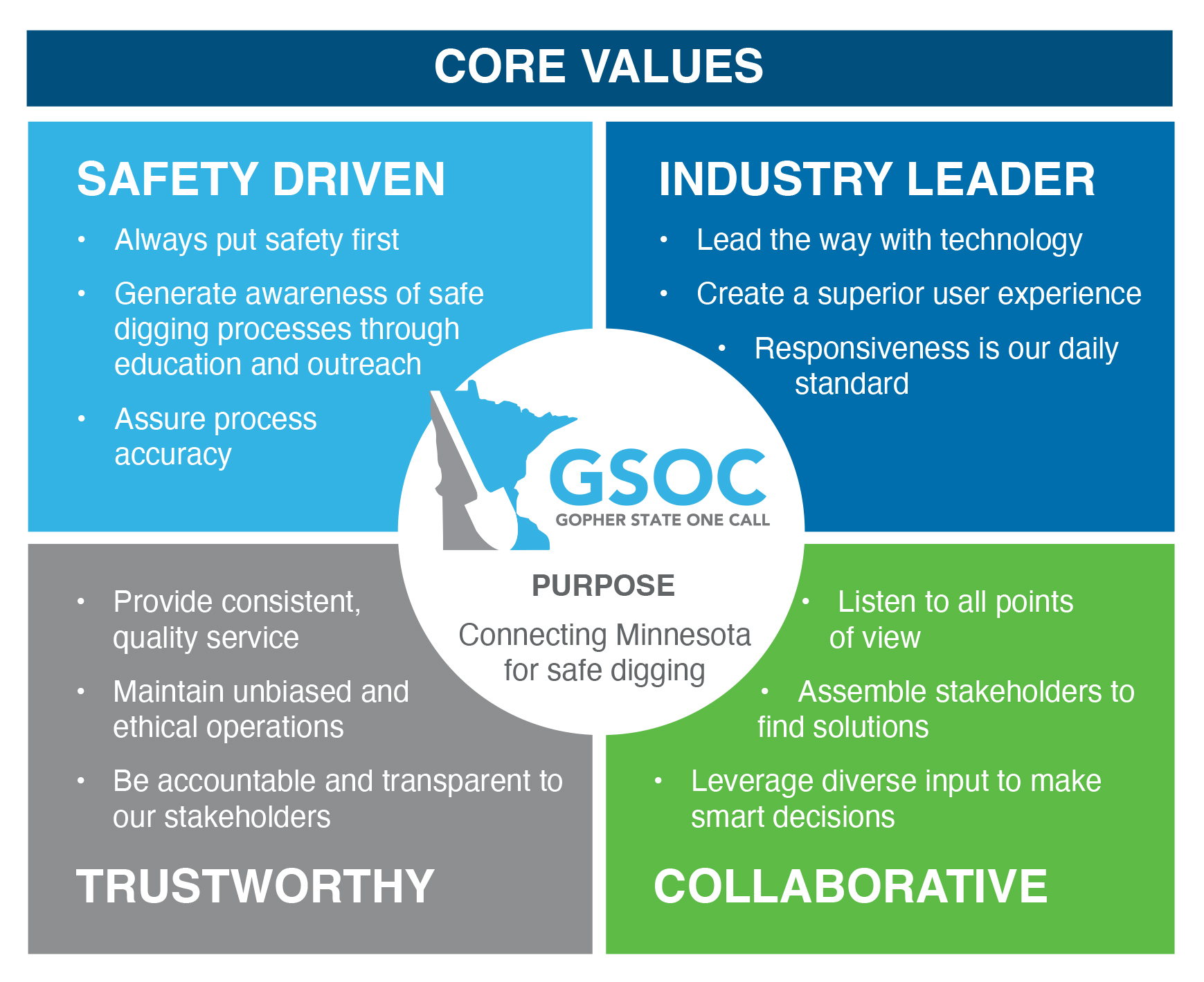Gopher State One-Call
Website Terms and Conditions
Last Updated: June 25, 2025
The Site; Consent to Terms
Welcome to www.GopherStateOneCall.org (together with any related websites maintained by us, the “Site”). The Site and the services provided thereon are provided by Gopher State One-Call, Minnesota non-profit corporation (“GSOC” or “we”,“our”, or “us”).
By accessing, visiting, or using the Site in any way, including, without limitation, by browsing the Site, using any information on the Site, interacting or attempting to interact with the Site, or submitting information to the Site, you agree to the following terms, conditions, policies and notices, together with any documents or policies they link to, reference or incorporate (collectively, these "Terms").
Please read these Terms carefully before using the Site. If you do not agree to these Terms, you should immediately exit and stop using the Site. If you have any concerns regarding these Terms, please contact us at customersupport@gopherstateonecall.org or use the contact form located on the Site.
Changes to the Site and These Terms
You acknowledge that all content on the Site, including these Terms, may change at any time, without any obligation on our part to notify you of such changes. When these Terms are updated, we will revise the “last updated” date stated above, but otherwise undertake no obligation to notify you that the Terms have changed. All changes are effective immediately when posted. It is your responsibility to review the Site, and these Terms, for any changes. Your use of the Site following any amendment or modification of these Terms will signify your agreement to and acceptance of its revised Terms.
We may, in our sole discretion, and at any time, discontinue the Site or any part thereof, with or without notice, or may prevent your use of the Site with or without notice to you. You agree that you do not have any rights in the Site or the content contained herein, and that we will have no liability to you if the Site is discontinued or your ability to access the Site or any content you may have posted or previously accessed on the Site is deleted.
Use of the Site
You may only use the Site for lawful purposes. Use of the Site to access, transmit, communicate, deliver, or store any information, data, content, or material in violation of any federal, state, local, or international regulation or law (including material protected by copyright, trademark, and trade secret or otherwise confidential information) is strictly prohibited. The Site is intended for, offered, and made available only to users who are 13 years of age or older. By using the Site, you represent and warrant that you meet all of the foregoing eligibility requirements. If you do not meet all of these requirements, you may not access or use the Site.
Geographic Restrictions
GSOC is based in, and exclusively provides services with respect to, the State of Minnesota in the United States. The Site is primarily intended for use by persons located in Minnesota. We make no claims that the Site is accessible or usable outside of the United States. Access to the Site may be illegal outside of the United States. If you access the Site from outside of the United States, you are fully responsible for your compliance with local laws.
Privacy Policy
GSOC maintains a privacy policy, located on the Site at www.gopherstateonecall.org (the “Privacy Policy”), which is hereby incorporated as a part of these Terms. The Privacy Policy sets forth how information about you is collected, used, and stored. Please read the Privacy Policy for more information about our information collection and use practices. Your use of the Site constitutes acknowledgement and agreement with the Privacy Policy. You further acknowledge and agree that the Site may collect and use your personal information in the manner described in the Privacy Policy.
Your Feedback
We welcome your comments, feedback, suggestions, and other communications regarding the Site and the information and services we make available through the Site (collectively, “Feedback”). The Feedback you provide to us through the Site will be and remain our exclusive property. Your submission of Feedback will constitute an assignment to us of all worldwide rights, title and interests in your Feedback, including all copyrights and other intellectual property rights in your Feedback. We will be entitled to reduce to practice, exploit, make, use, copy, disclose, display or perform publicly, distribute, improve and modify any Feedback you submit for any purpose whatsoever, without restriction and without compensating you in any way.
Registration; Accounts; Personal Information
Certain areas of the Site may require registration or may otherwise ask you to provide information (including personal information) to participate in certain features, access certain content, or to obtain certain promotional items. It is your responsibility to maintain the currency, completeness, and accuracy of your registration data and/or account access information, and any loss caused by your failure to do so is your responsibility. If the Site requires you to create an account or otherwise submit information, you agree that you will provide current, accurate and complete information for your user account; that you will not impersonate a third party in your communications with us; that you will only submit information about yourself or those for whom you are authorized to submit information; and that you will otherwise comply with these Terms. You may not authorize any other person or entity to use your account or to access restricted or protected content or features available at the Site.
If the Site requires you to create an account, you are solely responsible for the activity that occurs on your account, including all transactions and other activities undertaken with your device, whether authorized or unauthorized, and you must keep your user account, username, and password secure. If the Site requires you to create an account, you acknowledge and agree: (i) to notify us immediately of any breach of security or unauthorized use of your account; (ii) not to email, post, or otherwise disseminate any user name, password, or other information which provides you access to the Site; (iii) that we are not liable for any loss that you may incur as a result of someone else using your password or account, either with or without your knowledge; (iv) that we are not responsible for any losses arising out of the loss or theft of user information transmitted from or stored on a computer or device or from unauthorized or fraudulent transactions associated with the Site; (vi) to exit from your account at the end of each session on the Site; (vii) that you have no ownership rights in your account or other access to the Site or features therein; (viii) that we may terminate your access to the Site, cancel your account and/or delete all information associated with your account, including any materials you may have submitted to us, at any time, and without notice, for any reason; and (ix) that we assume no liability for any information removed from our Site and reserve the right to permanently restrict access to the Site or a user account.
Additional Terms; Call Center Operations
You understand and acknowledge that certain services and features that may be available on the Site may be subject to additional specific terms and conditions. In certain cases, you may be asked to agree (by checking a box or clicking on a button) to special terms governing your use of particular areas of the Site or services provided thereon. This type of agreement is referred to as a “click-through agreement.” In the event of any conflict between these Terms and any such specific terms and conditions, the specific terms and conditions will control.
In addition, we provide many of our services by contracting with One Call Concepts, Inc. (“OCC”). In particular, OCC operates GSOC’s call center and internet-based ticket services (the “ITIC” system). Your use of ITIC and OCC’s other software solutions to provide us with digital or electronic tickets is, therefore, subject to your acceptance of the terms and conditions of those programs, as published by OCC.
Content and Intellectual Property Ownership
All right, title and interest in and to the information, content, data, photographs, images, graphics, videos, audio, trademarks, service marks, logos, and other material (collectively, the "Site Content") available or displayed on the Site, including, without limitation, any copyrights in or to the Site Content, belong to GSOC and/or its content providers, industry partners or licensors (“Content Owners”), and is protected in the U.S. and internationally under trademark, copyright, privacy, and other intellectual property laws. In particular, but without limitation, "GOPHER STATE ONE CALL" ITIC, IMAP and all other trademarks, service marks, trade names and logos of ours appearing on the Site are the property of GSOC or another Content Owner. All uses of such marks shall inure solely to the benefit of the owner of such intellectual property. The use of any protected marks in conjunction with any other logos or marks shall not create a unitary or composite mark. Our trademarks, service marks, trade names and logos, and those of the other Content Owners, may not be used without our or their permission.
Any copying, redistribution, use or publication by you of any such content or any part of the Site is prohibited, except as expressly permitted in this Agreement. Under no circumstances will you acquire any ownership rights or other interest in any Site Content. The Site Content may not be reproduced, downloaded, disseminated, published, re-displayed or transferred in any form or by any means, without our written permission. You further agree to in no other way misuse any Site Content or third-party content that appears on the Site. Any unauthorized use of the Site Content may be a violation of federal, state, or international law subject to criminal and civil penalties.
Copyrights and Copyright Agent
If you believe your work has been copied in a way that constitutes copyright infringement, or your intellectual property rights have otherwise been violated, please provide a notice containing all of the following information to our Copyright Agent:
- An electronic or physical signature of the person authorized to act on behalf of the owner of the copyright or other intellectual property interest;
- A description of the copyrighted work that you claim has been infringed;
- A description of where the material that you claim is infringing is located on the Site;
- Your address, telephone number, and e-mail address;
- A statement by you that you have a good faith belief that the disputed use is not authorized by the copyright owner, its agent, or the law; and
- A statement by you, made under penalty of perjury, that the above information in your notice is accurate and that you are the copyright owner or authorized to act on the copyright owner's behalf.
Our Copyright Agent for notice of claims of copyright infringement on the Site is Kelly Connolly, who can be reached as follows:
By Mail: Gopher State One Call, 1100 Centre Point Curve, Suite 100, Mendota Heights, MN 55120
By Phone: 651-681-7308
By E-mail: kelly.connolly@gopherstateonecall.org
Our Function; Your Responsibilities
GSOC is an intermediary between underground facility operators and excavators. When an excavator notifies us of a planned excavation, we facilitate contact with relevant facility operators to let them know of the planned excavation, in order to allow such facility operators to comply with their statutory obligations. Our processes and functions are described in detail at gopherstateonecall.org.
To carry out these functions, we rely on the information used and/or provided by the underground facility operators and excavators. We receive information from underground facility operators as to where they operate, and the locations for potential excavations for which they want to be notified. If an underground facility operator’s mapping information is faulty, outdated, incomplete, or otherwise inaccurate, we will not be aware of it and therefore rely on inaccurate data. Our ability to contact the appropriate underground facility operator(s) is therefore constrained by the data provided to us, without the ability to confirm accuracy. We therefore disclaim any responsibility and liability for any errors based on the underground facility operators’ decisions or actions.
You further acknowledge and agree that you may need to obtain the services of a private locating company to locate private underground utilities or facilities on a property. The Site will not assist you in that. Such private locating services are available, and you must determine if they are needed.
Disclaimer of Warranties and Limitation of Liability
We strive to ensure that the information contained in the Site is accurate and reliable; however, errors may sometimes occur. Your use of the Site and consumption of the Site Content is not legal or business advice. Your compliance with applicable laws related to excavation activities (including for pre-excavation notification) remains your own liability.
THE SITE AND THE INFORMATION ON THE SITE IS PROVIDED ON AN “AS IS,” “AS AVAILABLE” BASIS. YOU AGREE THAT YOUR USE OF AND RELIANCE UPON THE SITE OR ANY CONTENT IS AT YOUR SOLE RISK. WE DISCLAIM ALL WARRANTIES OF ANY KIND, INCLUDING BUT NOT LIMITED TO ANY EXPRESS WARRANTIES, STATUTORY WARRANTIES, AND ANY IMPLIED WARRANTIES OF MERCHANTABILITY, FITNESS FOR A PARTICULAR PURPOSE, AND NON-INFRINGEMENT. WE MAKE NO WARRANTIES OR REPRESENTATIONS THAT YOUR USE OF OUR SERVICES OR THE SITE CONTENT WILL NOT INFRINGE THE RIGHTS OF OTHERS. WE DO NOT WARRANT OR REPRESENT THAT ANY FUNCTION OR CONTENT CONTAINED ON THIS WEBSITE OR ANY SERVICE WILL BE UNINTERRUPTED OR ERROR-FREE, THAT DEFECTS WILL BE CORRECTED, OR THAT THE SITE OR THE SERVER THAT MAKES IT AVAILABLE ARE FREE FROM VIRUSES OR OTHER HARMFUL COMPONENTS. WE DO NOT WARRANT OR MAKE ANY REPRESENTATION REGARDING THE USE, OR THE RESULT OF USE, OF ANY SERVICE OR CONTENT IN TERMS OF ACCURACY, RELIABILITY, OR OTHERWISE. WE DO NOT WARRANT OR MAKE ANY REPRESENTATIONS REGARDING THE LENGTH OF TIME THAT ANY SITE CONTENT WILL BE PRESERVED. YOU ACKNOWLEDGE AND AGREE THAT THE SITE CONTENT MAY INCLUDE TECHNICAL INACCURACIES OR TYPOGRAPHICAL ERRORS, AND WE MAY MAKE CHANGES OR IMPROVEMENTS TO THE SITE AT ANY TIME WITHOUT ANY OBLIGATION TO NOTIFY YOU. NO ADVICE OR INFORMATION, WHETHER ORAL OR WRITTEN, OBTAINED BY YOU FROM OR THROUGH THE SITE SHALL CREATE A WARRANTY OR REPRESENTATION NOT EXPRESSLY STATED IN THESE TERMS.
Limitation of Liability
UNDER NO CIRCUMSTANCES, INCLUDING NEGLIGENCE, SHALL WE BE LIABLE FOR ANY DIRECT, INDIRECT, INCIDENTAL, SPECIAL, PUNITIVE, OR CONSEQUENTIAL DAMAGES THAT RESULT FROM YOUR USE OF OR INABILITY TO USE (i) THE SITE OR ANY INFORMATION CONTAINED ON THE SITE, (ii) A THIRD-PARTY WEBSITE OR ANY INFORMATION CONTAINED ON A THIRD-PARTY WEBSITE (INCLUDING, WITHOUT LIMITATION, THOSE PROGRAMS OFFERED BY OCC), OR (iii) ANY SOCIAL MEDIA PLATFORMS LINKED TO THE SITE OR MAINTAINED BY OR FOR THE BENEFIT OF GSOC. WE SHALL ALSO NOT BE RESPONSIBLE FOR ANY DAMAGES WHATSOEVER THAT RESULT FROM MISTAKES, OMISSIONS, INTERRUPTIONS, DELETION OF FILES, ERRORS, DEFECTS, DELAYS IN OPERATION OR TRANSMISSION, OR ANY FAILURE OF PERFORMANCE, WHETHER OR NOT CAUSED BY EVENTS BEYOND OUR REASONABLE CONTROL.
Indemnification
You agree to defend, indemnify and hold GSOC, and its affiliates, subsidiaries, officers, directors, managers, employees, agents, licensors, vendors, representatives, and third-party providers harmless for any claims, judgments, awards, damages and, expenses, including reasonable attorneys' fees and costs, in any way related to (i) your access and use of the Site, including your use of any information obtained through the Site, (ii) your access and use any third-party website whether or not accessed through use and access of the Site, or (iii) your violation of these Terms, or unlawful or abusive behavior, including the infringement of any intellectual property or privacy rights of any person, or any violations thereof by any person who uses your account.
Third Party Websites
The Site provides links to third-party websites which are not owned, operated, or maintained by us, including, without limitation, those owned by or maintained for the benefit of OCC or the Minnesota Office of Pipeline Safety. We do not control those websites and are not responsible for the content of such websites. If, through use of and interacting with the Site, you are directed to and access a third-party website, you are subject to the terms and conditions and policies posted on those third-party websites, including any associated privacy policy. Those third party websites may contain information created, published, maintained, or otherwise posted by institutions or organizations independent of us. We make no representations or warranties about the content, currency, completeness, or accuracy of those third-party sites or information located on such sites. Access to any other websites linked to or from the Site is at your own discretion and risk. Furthermore, we are not responsible for the privacy practices of such other sites. The information you submit at a third-party site accessible from the Site is subject to the terms of that site's privacy policy, and we have no control over how your information is collected, used, shared, sold, or otherwise handled. Similarly, we have no control of or responsibility for any actions taken by third parties on the social media platforms linked on the Site or on which GSOC maintains a presence. We may disable links to any social media features at any time without notice in our discretion.
Miscellaneous
Applicable Law, Jurisdiction, and Venue. You agree that the internal laws of the United States and the State of Minnesota, without regard to conflicts of laws provisions, will govern these Terms and any dispute that may arise between you and us or our affiliates. By using the Site, you hereby agree that any and all disputes regarding these Terms will be exclusively subject to the federal, state and local courts in Ramsey County, Minnesota: you further agree to the personal and exclusive jurisdiction by and venue such courts. YOU AGREE THAT, TO THE EXTENT PERMITTED BY APPLICABLE LAW, ANY AND ALL DISPUTES, CLAIMS, AND CAUSES OF ACTION ARISING OUT OF OR CONNECTED WITH THE SITE AND/OR THESE TERMS, WILL BE RESOLVED INDIVIDUALLY, WITHOUT RESORT TO ANY FORM OF CLASS ACTION.
Severability. If any provision of these Terms shall be adjudged by any court of competent jurisdiction to be unenforceable or invalid, that provision shall be limited or eliminated to the minimum extent necessary so that these Terms will otherwise remain in full force and effect.
Waiver. Our failure to exercise or enforce any right or provision of these Terms shall not operate as a waiver of such right or provision. Any waiver of these Terms by us must be in writing and signed by an authorized representative of GSOC. The waiver of any right or provision of these Terms in a particular instance shall not constitute a waiver of any future right or the future application of such provision.
Entire Agreement. These Terms (including any other policies referenced or incorporated herein) constitute the entire agreement between you and us and governs the terms and conditions of your use of the Site, and supersede all prior or contemporaneous agreements, understandings, communications, and proposals, whether electronic, oral or written, between you and us with respect to the Site.
Headings. The headings in these Terms are for your convenience and reference only. These headings do not limit or affect these Terms.
© 2025 GSOC All rights reserved.

